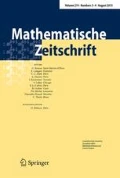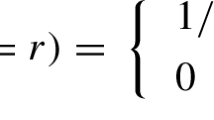Abstract
Let \(F\) be a global function field over a finite constant field and \(\infty \) a place of \(F\). The ring \(A\) of functions regular away from \(\infty \) in \(F\) is a Dedekind domain. For such \(A\) Goss defined a \(\zeta \)-function which is a continuous function from \(\mathbb{Z }_p\) to the ring of entire power series with coefficients in the completion \(F_\infty \) of \(F\) at \(\infty \). He asks what one can say about the distribution of the zeros of the entire function at any parameter of \(\mathbb{Z }_p\). In the simplest case \(A\) is the polynomial ring in one variable over a finite field. Here the question was settled completely by J. Sheats, after previous work by J. Diaz-Vargas, B. Poonen and D. Wan: for any parameter in \(\mathbb{Z }_p\) the zeros of the power series have pairwise different valuations and they lie in \(F_\infty \). In the present article we completely determine the distribution of zeros for the simplest case different from polynomial rings, namely \(A=\mathbb{F }\,\!{}_2[x,y]/(y^2+y+x^3+x+1)\)—this \(A\) has class number \(1\), it is the affine coordinate ring of a supersingular elliptic curve and the place \(\infty \) is \(\mathbb{F }\,\!{}_2\)-rational. The answer is slightly different from the above case of polynomial rings. For arbitrary \(A\) such that \(\infty \) is a rational place of \(F\), we describe a pattern in the distribution of zeros which we observed in some computational experiments. Finally, we present some precise conjectures on the fields of rationality of these zeroes for one particular hyperelliptic \(A\) of genus \(2\).
Similar content being viewed by others
Notes
For the convenience of the reader we indicate a proof of the non-trivial direction \(\Leftarrow \) using the notation from [17]: Suppose \(\Gamma (n)=\Gamma (n^{\prime })\) for some \(n^{\prime }\in \mathbb{N }\) with \(V_d(n^{\prime })\ne \emptyset \). Then \(n^{\prime }\) has a valid composition \((r_1,\ldots ,r_d)\). Define \(B\) as the matrix with columns \(\Gamma (r_i), \,i=1,\ldots ,d\). From property (ii) of a valid composition one deduces that the columns of \(B\) sum to \(\Gamma (n^{\prime })=\Gamma (n)\). Moreover \(\Gamma (r_i)\) lies in \(\mathcal J \) for \(i=1,\ldots ,d-1\). Now [17, Lem. 3.5] yields \(V_d(n)\supset V^B_d(n)\ne \emptyset \).
We thank Ralph Butenuth for writing Magma code that performed the factorization of precomputed special values.
References
Anderson, G.: \(t\)-motives. Duke Math. J. 53, 457–502 (1986)
Anderson, G.: An elementary approach to \(L\)-functions mod \(p\). J. Number Theory 80(2), 291–303 (2000)
Bautista-Ancona, V., Diaz-Vargas, J.: Index of maximality and Goss zeta function, preprint 2010
Böckle, G.: Global \(L\)-functions over function fields. Math. Ann. 323(4), 737–795 (2002)
Böckle, G., Pink, R.: Cohomological theory of crystals over function fields. In: Tracts in Mathematics, vol. 5. European Mathematical Society (2009)
Böckle, G.: Cohomological theory of crystals over function fields and applications. In: Bars, F., Longhi, I., Trihan, F. (eds.) Arithmetic Geometry in Positive Characteristic. Advanced Courses in Mathematics—CRM Barcelona. Birkhäuser, Basel. http://www.iwr.uni-heidelberg.de/groups/arith-geom/boeckle/Crystals-Barca.pdf. (2013, to appear)
Bosma, W., Cannon, J., Playoust, C.: The Magma algebra system. I. The user language. J. Symb. Comput. 24, 235–265 (1997)
Diaz-Vargas, J.: Riemann hypothesis for \({\mathbb{F}}\,\!{}_q[t]\). J. Number Theory 59(2), 313–318 (1996)
Gardeyn, F.: The structure of analytic \(\tau \)-sheaves. J. Number Theory 100(2), 332–362 (2003)
Hayes, D.: On the reduction of rank-one Drinfeld modules. Math. Comput. 57(195), 339–349 (1991)
Goss, D.: \(L\)-series of \(t\)-motives and Drinfeld modules. In: Goss, D., et al. (eds.) The Arithmetic of Function Fields, Proceedings of the Workshop at Ohio State University 1991, pp. 313–402. Walter de Gruyter, Berlin (1992)
Goss, D.: Basic Structures of function field arithmetic. In: Ergebnisse, vol. 35. Springer, Berlin etc. (1996)
Goss, D.: A Riemann hypothesis for characteristic \(p\) L-functions. J. Number Theory 82(2), 299–322 (2000)
Goss, D.: The impact of the infinite primes on the Riemann hypothesis for characteristic \(p\) valued L-series. In: Algebra, Arithmetic and Geometry with Applications (West Lafayette, IN, 2000). Springer, Berlin (2004)
Leitzel, J.R.C., Madan, M.L., Queen, C.S.: Algebraic function fields with small class number. J. Number Theory 7, 11–27 (1975)
Pink, R.: Private communication
Sheats, J.: The Riemann hypothesis for the Goss zeta function for \({\mathbb{F}}\,\!{}_q[T]\). J. Number Theory 71(1), 121–157 (1998)
Stichtenoth, H.: Algebraic function fields and codes. In: Graduate Texts in Mathematics, vol. 254. Springer, Berlin (2009)
Taguchi, Y., Wan, D.: \(L\)-functions of \(\phi \)-sheaves and Drinfeld modules. J. Am. Math. Soc. 9(3), 755–781 (1996)
Thakur, D.: Shtukas and Jacobi sums. Invent. Math. 111, 557–570 (1993)
Thakur, D.: On characteristic \(p\) zeta functions. Compositio Math. 99(3), 231–247 (1995)
Thakur, D.: Function Field Arithmetic. World Scientific (2004)
Thakur, D.: Valuations of \(v\)-adic power sums and zero distribution for Goss’ \(v\)-adic zeta for \({\mathbb{F}}\,\!{}_q[t]\), preprint 2011
Wan, D.: On the Riemann hypothesis for the characteristic \(p\) zeta function. J. Number Theory 58(1), 196–212 (1996)
Acknowledgments
I would like to thank Dinesh Thakur for several helpful conversations on the theme of the present article. In particular he suggested the calculations carried out in Sect. 8. For help with these calculations I thank Ralf Butenuth who wrote an efficient Magma routine to analyze polynomials over the field \(F_\infty \). The article was also influenced by the original proof of Proposition 7.1 by Richard Pink, turning cohomology into explicit formulas for \(\zeta \)-values. For a careful reading of the manuscript, I thank Yujia Qui. For its hospitality and the inspiring environment during spring of 2010, I thank the CRM Barcelona, where important initial work on this article took place. In this work, the author was supported by the SFB/TR45 and the SPP 1489 of the German Science Foundation DFG.
Author information
Authors and Affiliations
Corresponding author
Rights and permissions
About this article
Cite this article
Böckle, G. The distribution of the zeros of the Goss zeta-function for \(A=\mathbb{F }\,\!{}_2[x,y]/(y^2+y+x^3+x+1)\) . Math. Z. 275, 835–861 (2013). https://doi.org/10.1007/s00209-013-1162-9
Received:
Accepted:
Published:
Issue Date:
DOI: https://doi.org/10.1007/s00209-013-1162-9



